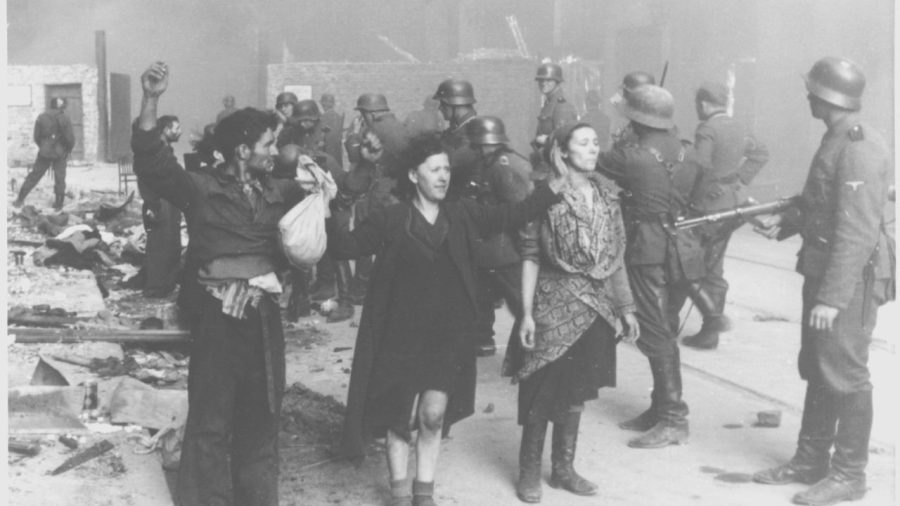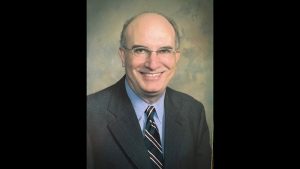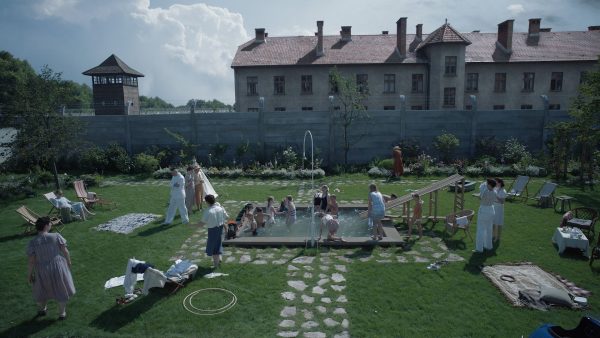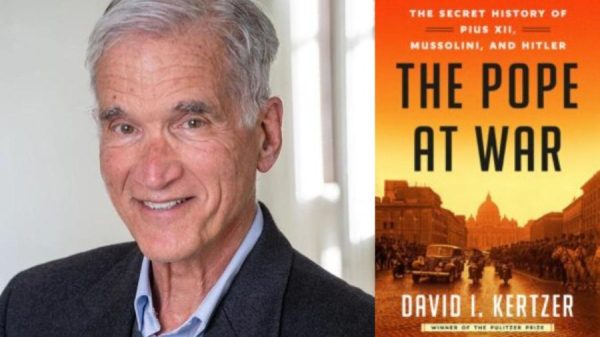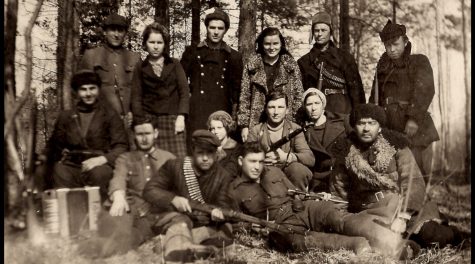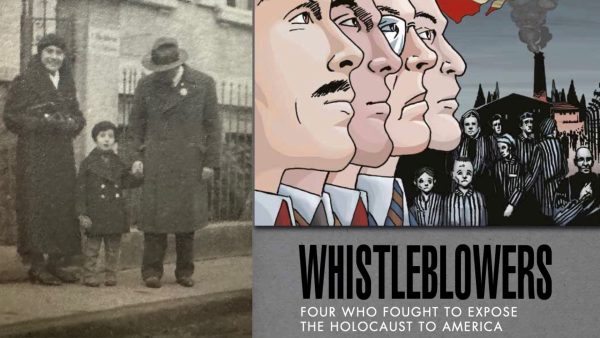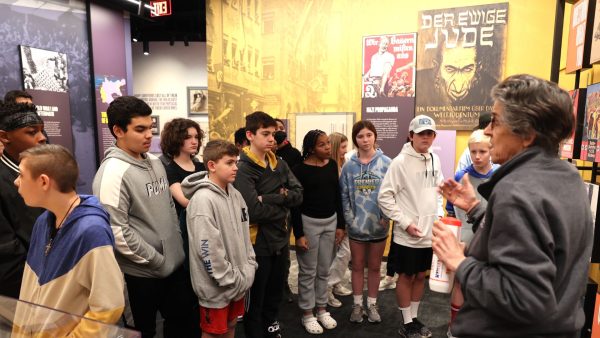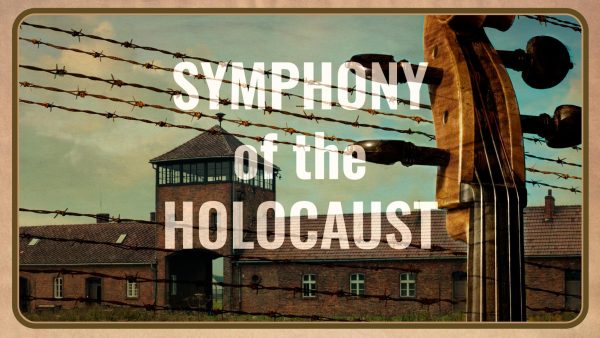These 7 facts about America’s role during the holocaust might surprise you
SS troops guard members of the Jewish resistance captured during the suppression of the Warsaw ghetto uprising. Picture between 19 April 1943 and 16 May 1943 taken at Nowolipie street looking East, near intersection with Smocza street. In the back one can see ghetto wall with a gate. (US Holocaust Memorial Museum/Wikimedia Commons)
Published September 15, 2022
Growing up, I always took some small comfort in the fact that the Holocaust was something that happened over there, in Europe, and not in my United States.
Sure, America had its problems, but we were not tainted by the anti-Jewish fervor that swept Europe in the 1930s and ’40s and resulted in a genocidal Nazi campaign that killed 6 million Jews.
But did you know that Adolf Hitler actually cited discriminatory policies in the United States to defend his own anti-Jewish policies?
The Nazi leader had read about how European settlers in America pushed aside Native American populations in conquering the continent, decimating their numbers and confining them to small reservations. Additionally, he noted how America relegated its African American population to second-class citizenship.
“The immense inner strength of the United States came from the ruthless but necessary act of murdering Native people and herding the rest into cages,” Hitler was quoted as saying.
In 1935, Nazi Germany passed the Nuremberg Laws, which stripped German Jews of their citizenship and outlawed marriage between Jews and non-Jewish Germans. When Germany was reprimanded for the new laws, Nazi officials cited racist Jim Crow laws in U.S. states outlawing interracial marriage and disenfranchising Black people.
And as Hitler eyed the conquest of lands to Germany’s east, he cited the U.S. model, saying that just as America had conquered the Wild West, Germany needed to conquer the “Wild East”— that is, Eastern Europe and the Soviet Union.
“Our Mississippi must be the Volga,” Hitler said, referencing the river that runs through central Russia to the Caspian Sea.
These are just some of the startling facts laid bare in the new PBS documentary from Ken Burns, Lynn Novick and Sarah Botstein, “The U.S. and the Holocaust,” a three-part series scheduled to air for three consecutive nights beginning Sunday, Sept. 18.
The six-hour film offers a fresh look not just at Hitler’s brutal campaign against European Jewry, but how Americans — and America — reacted to it. Using archival footage and insights from historians and survivors, Burns’ film documents both tragedy and heroism in the story of how Americans responded to the Holocaust.
Here are some other facts from the new PBS documentary that may surprise you.
America had become staunchly anti-immigrant in the decades leading up to the Holocaust, making it exceedingly difficult for Jews fleeing Hitler’s Germany in the 1930s to enter the United States.
For generations, America’s borders had been mostly open, and nearly 25 million immigrants arrived between 1870 and 1914, mostly from southern and eastern Europe.
But by the early 1920s, American public opinion had become staunchly anti-immigrant, and in 1924 Congress passed a new law severely restricting immigration. Although it didn’t specifically target Jews, the quota was miniscule for immigrants from eastern European countries, where most Jews lived.
Meanwhile, many Americans embraced eugenics, the false theory that human beings could be perfected through “racial improvement” and “planned breeding.” These Americans believed that immigrants were part of the problem. During this period, 33 of the 48 states mandated sterilization of certain persons deemed undesirable, ultimately resulting in the forced sterilization of more than 60,000 Americans.
Eugenics was so popular that it was taught in colleges and supported by such figures as Helen Keller and Alexander Graham Bell.
“I wish very much that the wrong people could be prevented entirely from breeding,” Theodore Roosevelt said several years after serving as president. “Criminals should be sterilized and feeble-minded persons forbidden to leave offspring behind them.”
When Nazi Germany began persecuting Jews in the 1930s, some American Jews feared that protesting publicly would backfire.
American newspapers carried more than 3,000 stories about antisemitic incidents in Germany during just the first 100 days of Nazi rule. Many Americans were appalled at what was happening. But others were skeptical because lurid reports they had heard about German atrocities during World War I turned out to be false.
For their part, many American Jews were torn. They were continually told by political leaders that if they spoke out and made a fuss, it would only make the situation worse for Germany’s Jews. And there was concern that if the Jews spoke out too much, other Americans would view the Nazi issue as a Jewish problem rather than a universal one.
On March 27, 1933, more than 30,000 people filled Madison Square Garden (another 35,000 stood outside) for a rally against Nazism. Rabbi Stephen Wise, a brilliant orator and charismatic leader, told the crowd: “We must speak up like men. How can we ask our Christian friends to lift their voices in protest against the wrongs suffered by Jews if we keep silent? What is happening in Germany today may happen tomorrow in any other land on Earth unless it is challenged and rebuked. It is not the German Jews who are attacked, it is the Jews.”
Roosevelt faced very little public pressure to help Europe’s Jews in the 1930s.
Franklin D. Roosevelt was elected president in 1932 while carrying an estimated 70% to 80% of the Jewish vote. Once in the White House, he appointed more Jews to his administration than any president before him.
But some conspiracy theorists claimed Roosevelt was secretly Jewish and that his real last name was Rosenfeld, and right wingers denounced FDR’s New Deal as the “Jew Deal.”
Even as things went from bad to worse in Nazi Germany, U.S. public opinion remained strongly against easing existing immigration restrictions, especially for penniless Jewish refugees. Two-thirds of Americans polled in 1938 said the bad things happening to Jews in Europe were partly or entirely the Jews’ own fault.
While FDR withdrew his ambassador to Berlin after Kristallnacht in 1938 — the only world leader to do so — and worked behind the scenes to pressure Latin American nations into taking in 40,000 Jewish refugees during the early stages of World War II, there was no relaxation of U.S. immigration restrictions, even for European Jews fleeing Nazism. The United States had no refugee policies or protections until after World War II.
By the end of 1938, half of all Jews born in Germany had applied for immigration visas to the United States. Most would not make it in.
Even among America’s Jews, a 1939 poll found that one-quarter opposed offering sanctuary for European refugees. Among Catholics and Protestants, about 85% were opposed.
Many American corporations did business with Hitler’s prewar regime.
Automobile magnate Henry Ford’s embrace of Nazism is well-known. In the 1930s, Ford provided the German army with 1,500 vehicles per year while turning down an offer to build airplane parts for Britain. In 1938, Nazi Germany awarded Ford its highest civilian medal.
But Ford was far from the only American corporation to collaborate with the Nazis before the war.
Woolworth’s retail stores fired all its Jewish employees in Germany as the price of doing business in Germany. So did the Berlin office of the Associated Press. Between 1933, when the Nazis rose to power, and 1939, when the war began, Hollywood uttered nary a word against the Nazi regime. Footage from newsreels about Germany usually were confined to material produced by Nazi Germany itself, with few exceptions.
Passengers aboard the rejected ship the MS St. Louis were not returned to Nazi Germany, and most survived the war.
The MS St. Louis sailed from Hamburg, Germany, in May 1939 carrying more than 900 Jewish refugees, and famously failed to find safe haven in the United States. But America wasn’t its original destination. It sailed from Europe bound for Havana, but the ship was rejected at port when the passengers’ Cuban tourist visas were summarily invalidated. Then it turned toward Florida. Both U.S. and Canadian authorities were unwilling to accept the refugees, and the doomed ship headed back to Nazi Germany.
The ship’s sympathetic captain considered intentionally running the ship aground near England in order to save the passengers. Eventually, four countries agreed to each take one-quarter of the passengers: Belgium, France, Holland and Britain. Sadly, one-quarter of the passengers eventually would be killed when the countries that had given them refuge were later overrun by the Nazis.
The MS St. Louis was actually an anomaly. Nearly 1,200 passenger ships carrying over 110,000 self-identified European Jewish immigrants arrived in New York between March 1938 and October 1941.
By the time US forces reached Europe, three-quarters of the Jewish victims of the Holocaust were already dead.
About 75% of the 6 million Jews who died during the Holocaust were killed during a single 20-month period. By the time U.S. forces landed in Normandy, France, in the spring of ’44, 5 million Jews had been killed.
American Jews often ask why America didn’t bomb the Nazi concentration camps to try to stop the killing. For most of the war, this question was irrelevant: It simply wasn’t possible.
Before any American soldier arrived in continental Europe in September 1943 (in southern Italy) 4.5 million Jews were already dead, and 90% of them had been killed in the northeast quadrant of the continent: Poland, Lithuania, and the present-day territories of Belarus and Ukraine. No U.S. aircraft had the range to fly to any of the killing centers in those areas to impede the killing process while it was most intense in 1942 and January 1943.
When U.S. troops finally were close enough, they did not bomb the camps. Military commanders did not want to bear direct responsibility for killing the camps’ prisoners, and the War Department claimed that diverting airplanes to bomb the railways to the camps would be ineffective. The best way to end the killing, U.S. authorities said again and again, was to win the war.
PBS
This story was sponsored by and produced in collaboration with PBS, which will air “The U.S. and the Holocaust” on three consecutive nights beginning Sunday, September 18 at 8 P.M. Eastern. This article was produced by Hey Alma’s native content team.



